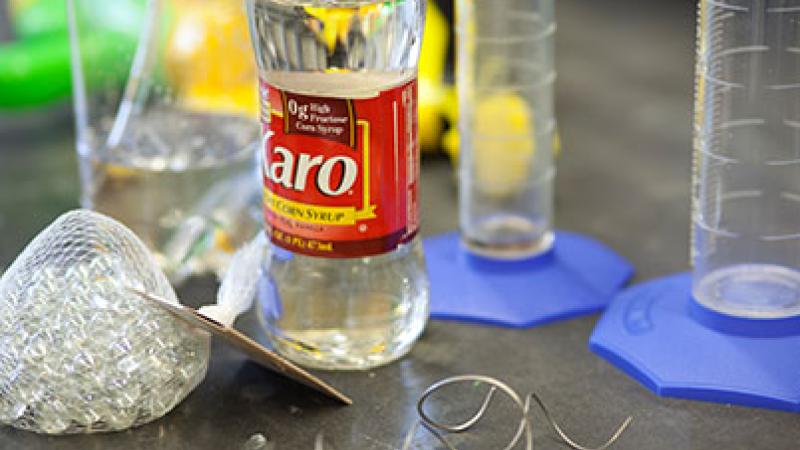Faculty-Student Team at Rensselaer Polytechnic Institute Creates Fun-Filled “Science in a Box” Kits for University Professors to Run Workshops at Local High Schools
September 10, 2012

Educational outreach is a critical component of nearly every research grant awarded by the federal government or other funding organizations. Along with conducting experiments and documenting the results, grant recipients are tasked with reaching out to high schools and lower schools to help expose and excite students about science, technology, engineering, and mathematics. Not every grant recipient, however, knows how or where to start these outreach activities.
Engineers at Rensselaer Polytechnic Institute are here to help. Professor Patrick Underhill and senior Hannah Fix spent the summer developing four “kits” that contain everything needed for researchers to run a fun-filled, memorable educational outreach workshop on the topic of fluid physics at their local high school. Along with different everyday objects—from water guns to corn syrup to caulk—the kits include worksheets for students, presentation slides, and a teacher’s guide. The kits are field-tested, peer-reviewed, and intended to be donated to the high school so teachers can duplicate the demonstrations and experiments.
See a video of Underhill and Fix talking about the project at: http://youtu.be/ne7uHfwp2MI.
“We believe these kits are a great way to illustrate some of the basic principles of fluid physics that are taught in high school physics and chemistry classes,” said Underhill, assistant professor in the Howard P. Isermann Department of Chemical and Biological Engineering at Rensselaer. “We want to arm researchers and graduate students with the right tools to make their educational outreach programs as impactful as possible, and to help inspire and encourage high school students to pursue a university degree and maybe even a career in science, technology, engineering, or math.”
Fix, an aerospace and mechanical engineering major from Frederick, Md., has been working with Underhill to develop and refine the kits. She said the kits were designed to include everyday objects that are familiar to the students, but also easy and inexpensive for the teacher to replace if lost or broken. Worksheets in the kits guide the students through the activity. Students are introduced to the topics and then calculate theoretical results using formulas, before conducting the experiments and comparing the theoretical results with the experimental data.
“Most of the experiments are things you see in everyday life. We’re using these kits to get the students interested and excited in the physics behind these everyday things,” said Fix, who intended to study veterinary medicine but was inspired by her high school’s robotics club to pursue engineering.
The four kits are:
- Water Gun: How many pumps of a water gun does it take to hit a target at a known distance?
Students try to hit targets with a water gun, and measure the pressure required to make the water travel to the target. Key learning points: Ballistics, conservation of energy, Bernoulli principle, ideal gas law, conservation of mass. - Viscous Drag: How long does it take a sphere to fall through a liquid?
Students measure the time it takes two different glass beads, of different diameters, to fall through water or corn syrup. Key learning points: Force balances, gravity, viscous drag, buoyancy. - Heron’s Fountain: operation and analysis
Students build a Heron’s Fountain from plastic drink containers, copper tubing, and silicon sealant, before demonstrating the fountain. Key learning points: Bernoulli’s equation, pressure, potential energy, kinetic energy. - Gravity-Defying Siphon: Why is water flowing up instead of down?
Students build a siphon that pumps water up a tube and then down a different tube, and are asked to calculate and demonstrate the amount of time it takes to fill a bucket. Key learning points: Bernoulli’s equation, conservation of mass, conservation of energy, viscous drag.
The kits were informed by direct feedback from high school teachers. Additionally, Underhill and Fix will soon send out about a dozen kits to graduate students and university professors. These test users will run workshops with the kits at their local high schools, and provide feedback and suggestions which will be incorporated into the final kits. Once finalized, Underhill plans to spread word about the kits and send them out free of charge to interested university professors and graduate students so they may run high school outreach events. Following the event, the kits will be left with the high school teachers for later use. The final kits are expected to be available in November.
This project and the kits are funded by the Division of Fluid Dynamics of the American Physical Society, with support from the Undergraduate Research Program at Rensselaer. Underhill and Fix are working on the project in partnership with researchers at the United States Naval Academy and Los Alamos National Laboratory.
Underhill is a faculty member of the Center for Biotechnology and Interdisciplinary Studies at Rensselaer.
For more information on Underhill’s research at Rensselaer, visit:
- Faculty Home Page
http://homepages.rpi.edu/~underp3/ - Ulcer-Causing Bacteria Baffled by Mucus
http://news.rpi.edu/update.do?artcenterkey=2976 - Rensselaer Professor Patrick Underhill Receives NSF CAREER Award
http://news.rpi.edu/update.do?artcenterkey=2733